The champion approach to next-level digital experiences
Champions understand that employees and customers expect a great digital experience with every digital product and service. Why is a product mindset more effective than a project mindset in achieving this goal?
From good to great
Many companies are becoming software companies, creating new digital products to serve their customers and partners better. The repercussions are enormous: researchers expect that 40% of total revenue for the largest 2,000 organizations globally will be generated by digital products, services, and experiences by 2026. From manufacturing furniture to filling prescriptions, 50% of companies—and 70% of top performers—now use software applications they developed internally to differentiate themselves from their competition.
The payoff can be enormous as well. In a recent global IBV study, organizations reported an astonishing ROI of 46% and 75% on new and existing digital product enhancements, respectively.
Digital products and enhancements are substantial drivers of revenue and ROI.
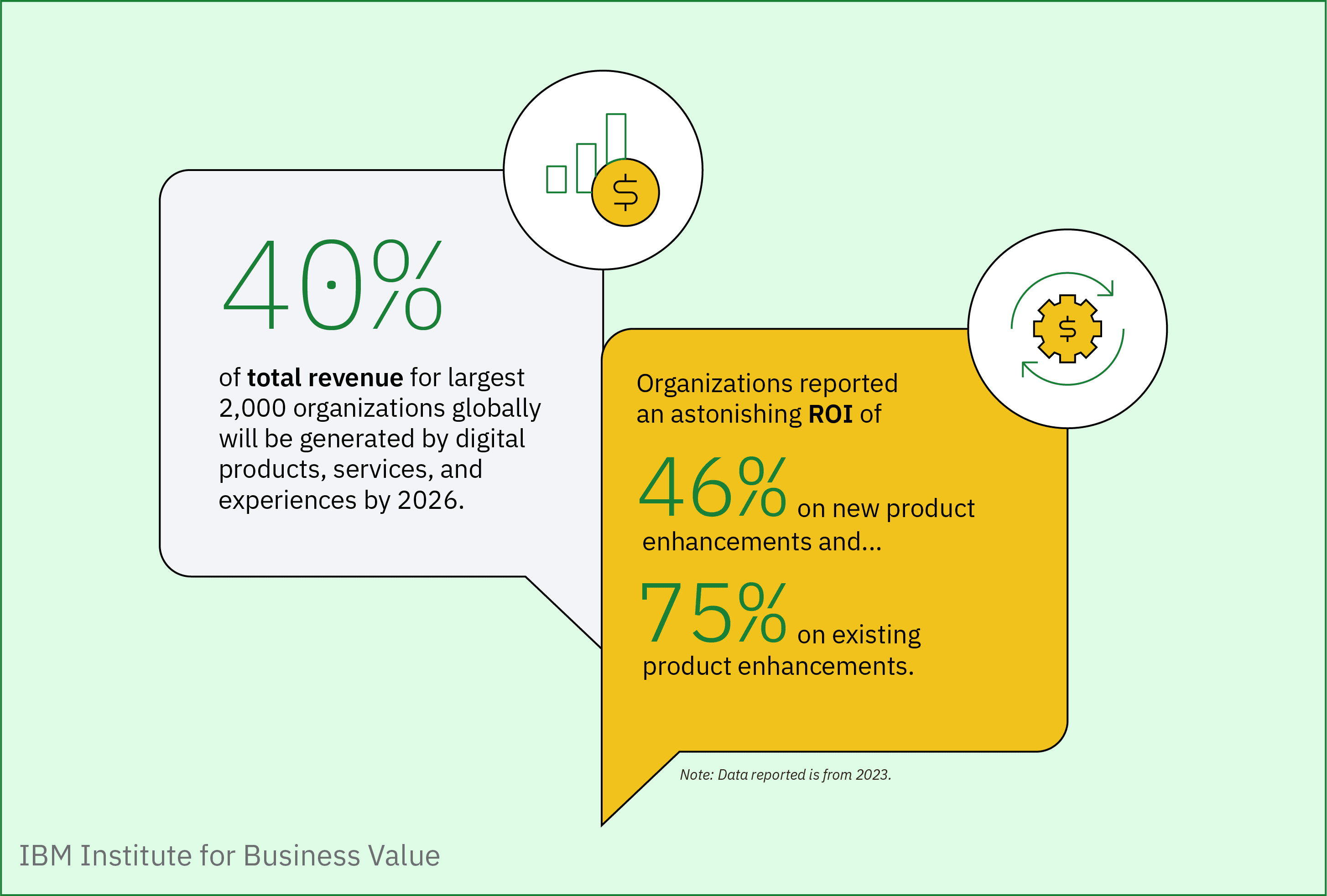
Given the growing importance of digital products, we surveyed 300 US organizations to understand their approaches to digital product development. Among the highest performers, we noticed there was a clear difference in what separated the good results from the great results.
Two groups emerged: those that define a product mindset only as a series of tasks or a work structure, and those that adopt a true product mindset, creating a holistic experience for the customer throughout the full life cycle of the product. We’ve identified the first group as Project Planners and the second as Value Champions. Surprisingly, both enjoy positive business results—in the short term. But Value Champions are notably better positioned for long-term success.
Value Champions versus Project Planners:
Both groups perform highly, but only one is positioned for lasting success.
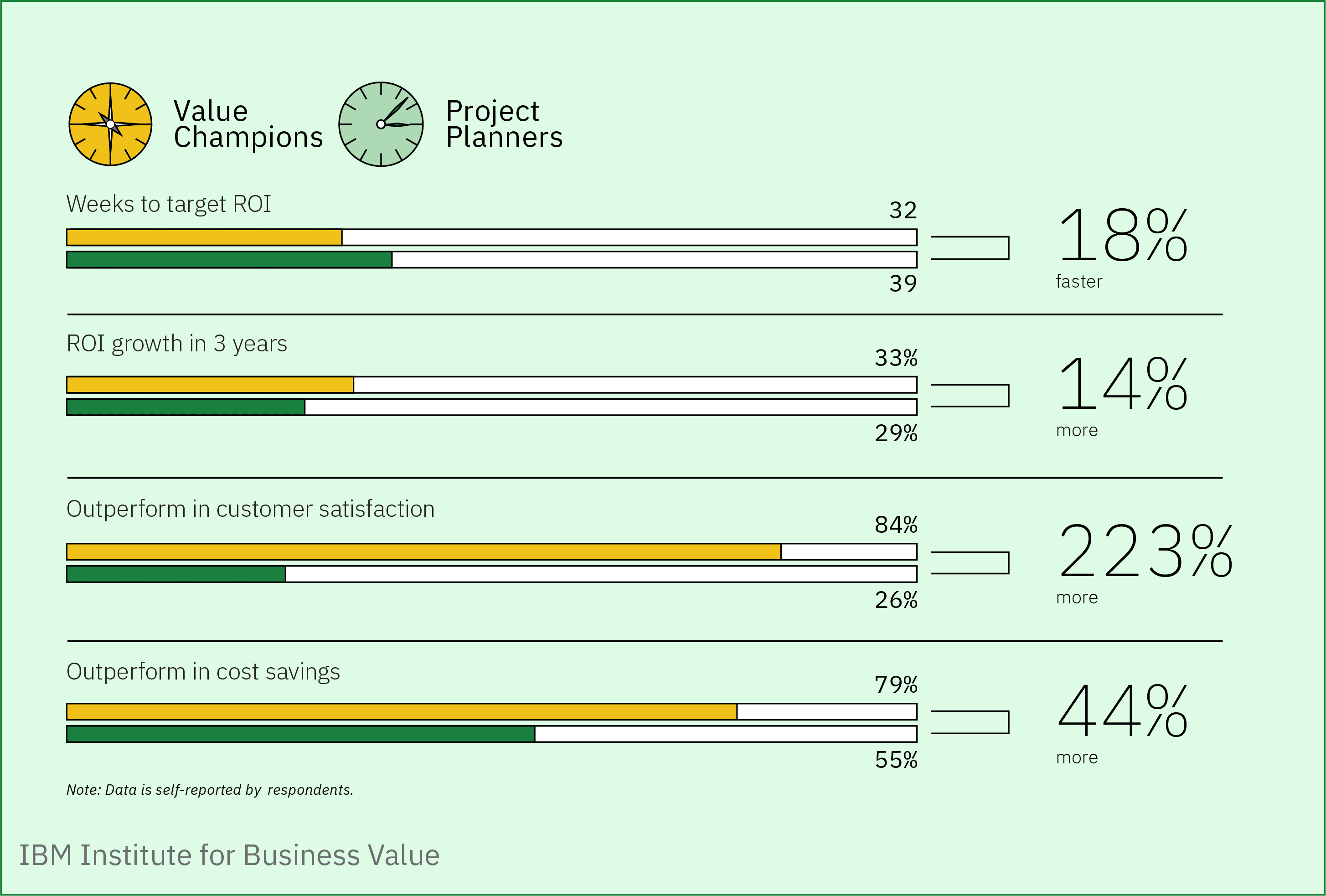
Project Planners fall firmly in the “series of tasks” camp. They march to a project mindset that focuses on deliverables, schedules, activities, and a completion date—but this emphasis can distract from determining the actual value delivered.
Despite their myopic perspective, Project Planners still perform quite well in revenue growth and profitability. However, these results are likely to be short-lived because they notably underperform in customer satisfaction and innovation, which does not bode well for the future.
On the other hand, Value Champions embrace a powerful product mindset, finding ways to systemize the intake of customer, business, and product needs to help ensure value is at the heart of each release.
Successfully balancing customer value with business value and product value, Value Champions achieve their target ROI up to seven weeks faster (18% faster) than Project Planners. And nearly eight in ten (79%) report outperforming their competition in cost savings.
Value obsession: At the heart of champions
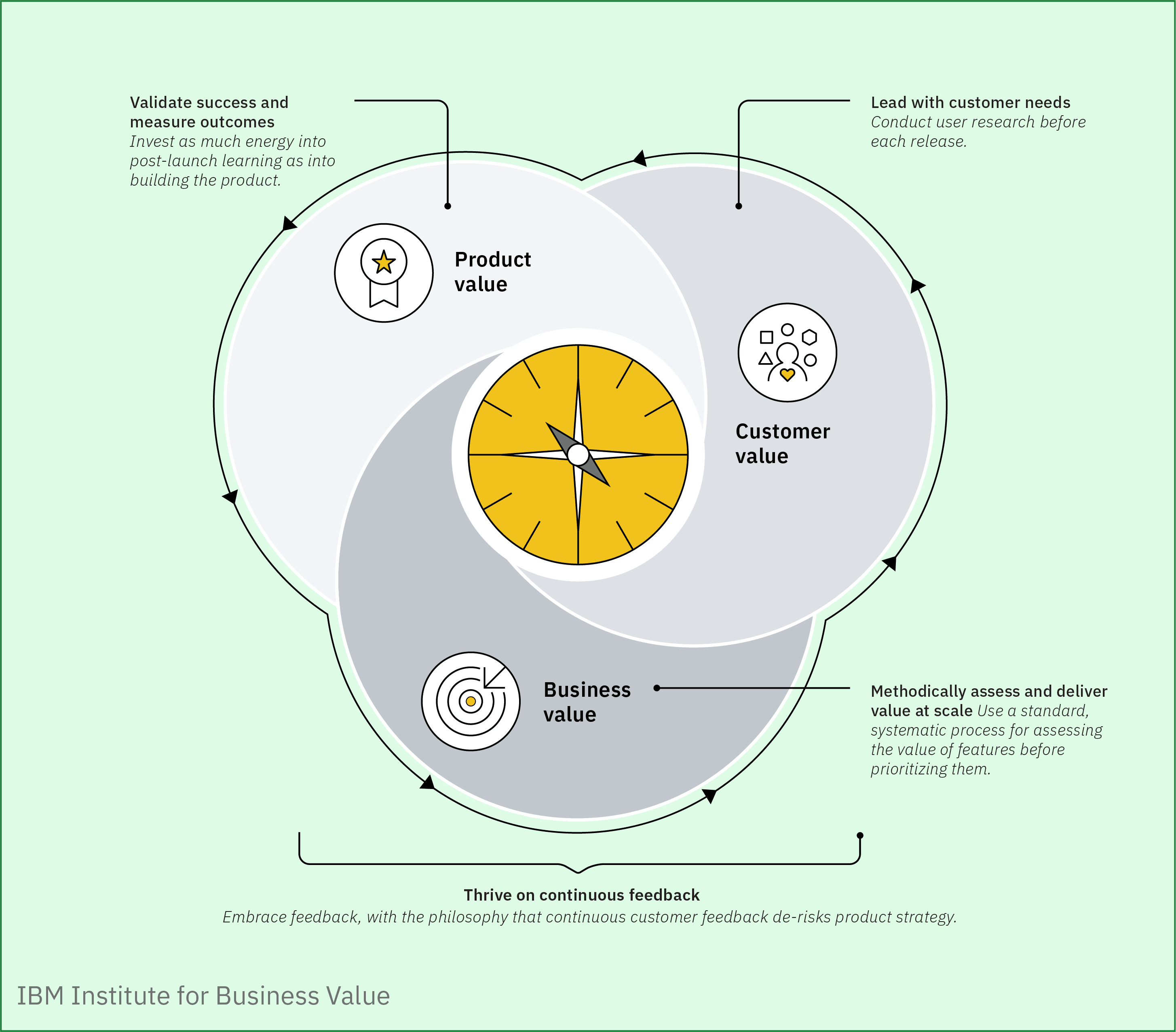
Value Champions also exemplify how a purpose-driven culture fosters strong unity throughout the enterprise, with a focused vision and cohesiveness that create higher employee morale and satisfaction across IT and business teams. This philosophy is widespread in successful organizations: research shows that CEOs of outperforming organizations identify a sense of purpose as mission-critical for employee engagement at a rate 53% higher than underperformers.
Why adopt a Value Champion approach?
If values such as customer and employee satisfaction haven’t convinced you, consider this. Our research shows a customer advocacy strategy doesn’t just benefit customers—it’s good business as well.
84% of Value Champions report outperforming competitors in customer satisfaction, compared to only 26% of Project Planners.
And 89% of Value Champions reported their product increased their customer retention in 2022.
Customer needs continuously change—and so do business needs. Champions are ready. They systematically assess the value of what they’ll work on next—enabling quick shifts that both align with market changes and make sense for the organization.
For the most part, Project Planners haven’t developed these systematic approaches. Although they achieve their monetary targets today, without prioritizing continuous innovation, customer feedback, and overall value, they risk losing momentum going forward. The inevitable customer and business pivots that Champions manage gracefully can derail their Project Planner counterparts.
How can your organization become a Value Champion?
Our research reveals three distinct strategies that differentiate them from their Project Planner peers—strategies that virtually any organization could emulate. So, let’s get started.
1. Use continuous, value-based iterations to boost business results that matter—today and in the future.
Frequent releases may achieve milestones for a corporate objective, agile sprint, or team performance plan. But what are they accomplishing?
Project Planners tend to minimize this critical detail. This group releases products iteratively, yet their releases are deploying features based on predetermined schedules rather than strategic launches based on value and associated feedback.
They are missing something essential—a protocol for determining customer, business, and product value before establishing priorities (see Perspective “Balancing act”). In fact, more than half of this group (53%) lack a system for assessing the value of features at all before prioritizing them.
The problem lies, in part, with the classic success criteria used in project management: on-schedule, on-budget, and on-quality delivery. But what’s missing? Value: a dedication to value-based outcomes over a product’s lifespan. An on-time, on-budget, high-quality project that doesn’t meet customer and business needs—or evolve with them—actually adds no value at all.
While adhering to a schedule is well and good, not all releases are created equal. Value Champions opt for organizationally aligned, customer-centric launches over simply deploying new code. They release strategically with customer, business, and product value top of mind, rather than speed, cost, or feasibility alone.
These launches are primarily enabled by Value Champions’ systemized ability to absorb customer and organizational feedback, assess value, and prioritize accordingly.
Our research also uncovered a paradox. Given their strict adherence to schedules, you would think Project Planners move faster than value-obsessed Champions. In reality, it’s the other way around. Champions release new features every 12 weeks—three weeks (18%) faster than Project Planners.
More impressively, Value Champions also achieve financial metrics that are well-positioned for growth going forward. Our research shows a skyrocketing average ROI increase for their digital product of 33% in just three years, and projected ROI of 76% growth from 2020–2025.
Outcomes are what counts
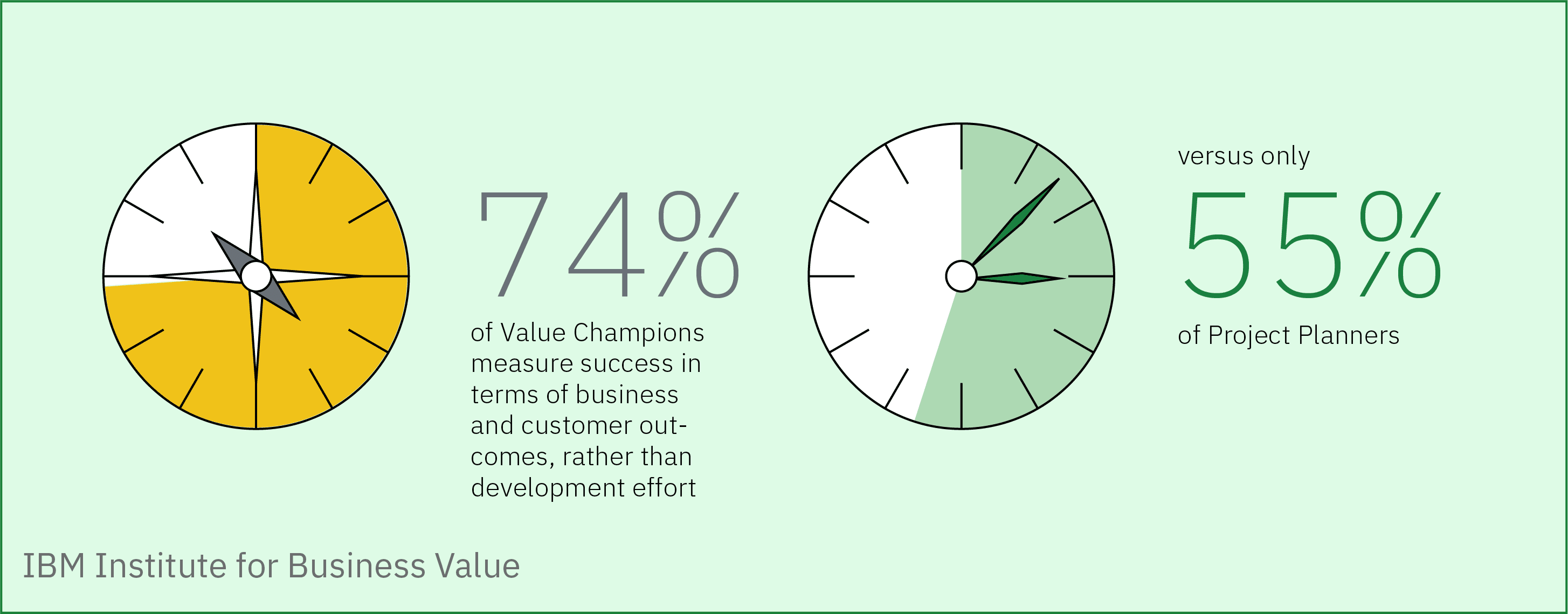
Perspective
 |
|
| |
 |
|
| |
 |
|
| |
2. Operationalize a system that evolves with customer and business needs.
The trifecta of customer, business, and product value measurement is powerful. But how do Value Champions keep up with continuously shifting needs? Why do Project Planners lag behind?
For starters, Value Champions have a deep understanding of their customer and have an ability to evolve with change.
What do customers actually want and need today? In a month? In a year?
While Value Champions invest deeply in continuous customer learning, Project Planners could well respond with a blank stare—monitoring, analyzing, and keeping pace with customer needs is their Achilles heel. They can only guess at what customers need today and certainly aren’t anticipating what they’ll need tomorrow.
Surprisingly, four in ten (41%) of Project Planners lack a standardized method for collecting post-launch customer feedback. They do go through the motions of conducting user research, but it can be, to an extent, performative. Only 51% of Project Planners view their digital product as a lifelong, continuously evolving initiative, compared to 89% of Value Champions. In other words, they’re viewing their product as a project—an ill-advised strategy in the continuously changing world we live in.
Value champions make the commitment
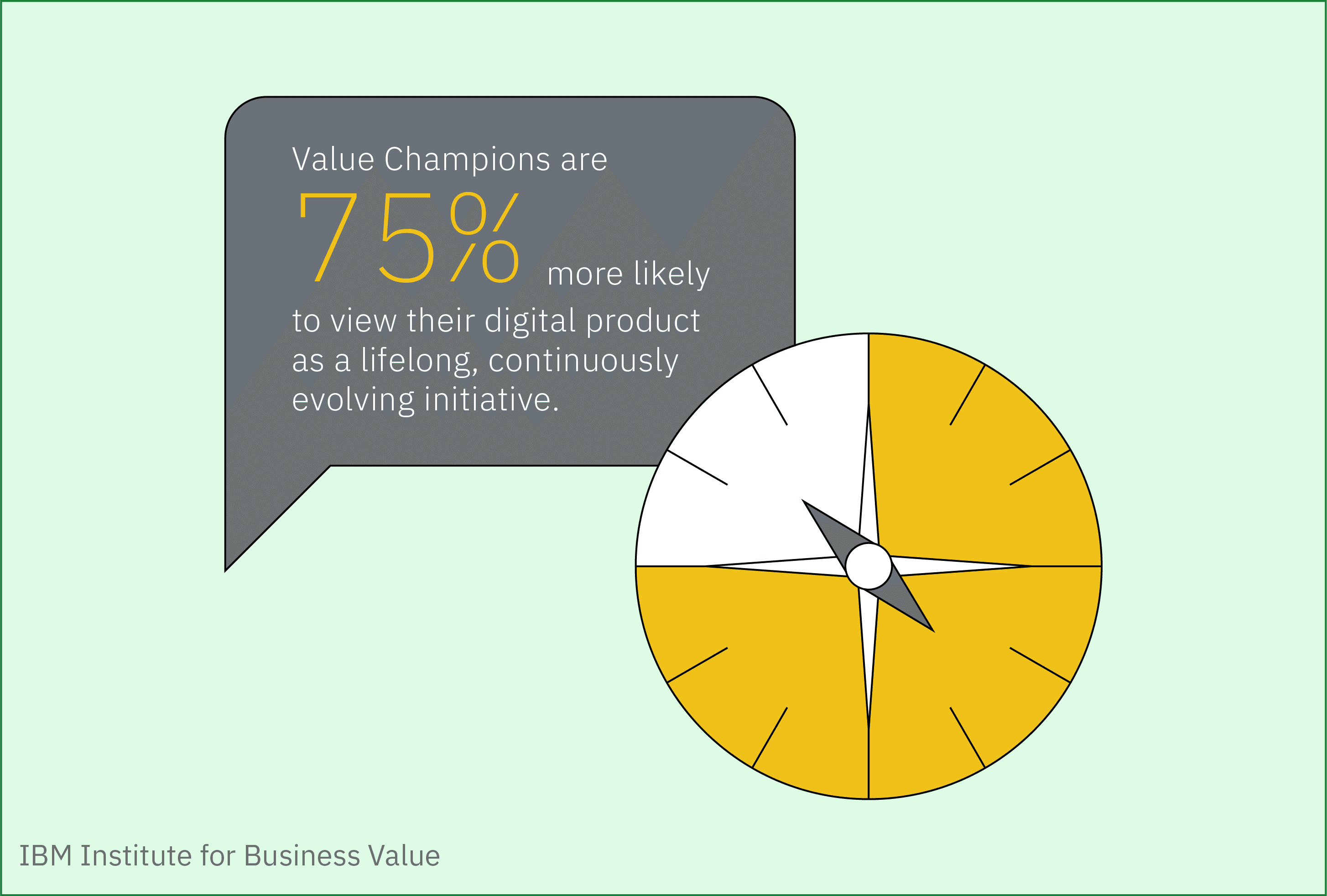
As well, Value Champions systemize their prioritization of features. Customer value is a large part of that formula—but how does it balance against business value and actual product improvements? And how can it be monitored? Measuring value at enterprise scale requires methodically tracing value from inception to outcome–nurturing high-value opportunities and leaving behind lower-value, resource-guzzling efforts.
Value Champions have mastered operationalizing—in a sense, orchestrating—value.
As a starting point, consider four steps to delivering value at scale:
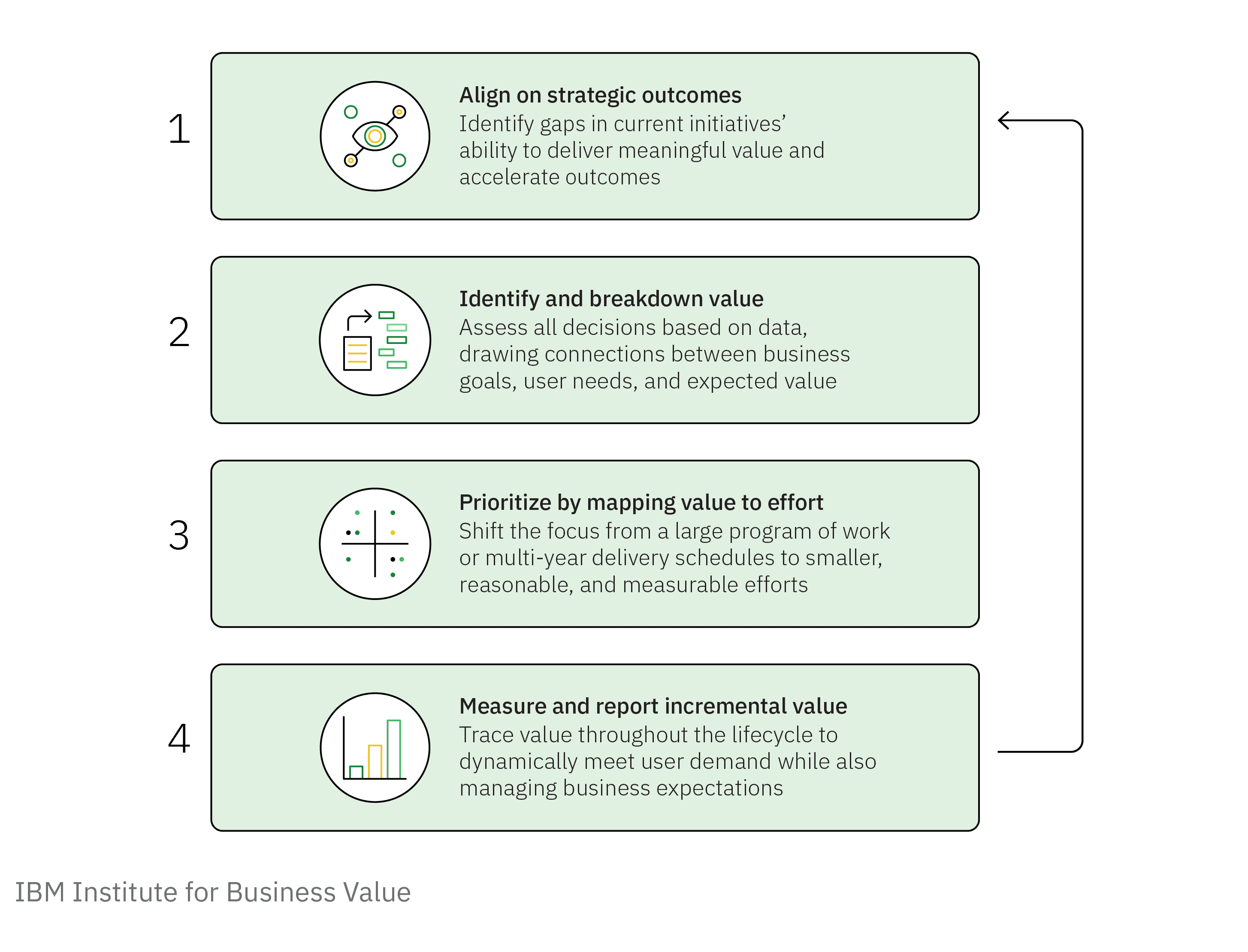
Value orchestration is all about responsiveness and fluidity. By concentrating on these four logical steps, organizations can be both reactive and effective. They can recognize and evaluate market opportunities—and improvise quickly and iteratively to develop solutions that deliver real value.
And generative AI can further streamline the responsiveness that comes with value orchestration. This technology can be trained to highlight feedback and ideas most aligned with business strategies, and to minimize or eliminate what’s not relevant. In fact, 62% of global executives say that generative AI is the top trend they expect to disrupt the way their organizations design experiences going forward.
Perspective
Generative AI
Hunter, gatherer, interpreter of customer feedback
According to IBM IBV research, 85% of execs say generative AI will interact directly with customers in the next two years. But the real value comes as the technology grows more sophisticated. That’s when agents can forge the emotional connections with customers that yield fresh new insights and opportunities. It’s about taking risks—and conquering them—with the help of this ever-advancing technology. In effect, generative AI is a research tool to collect and analyze sentiment-based metrics for each customer service interaction—rapidly analyzing and prioritizing large volumes of feedback.
And generative AI is not just for facilitating and analyzing interactions and engagement—it can also drive innovation. Organizations can use it to mine new opportunities with customers and monitor customer service success to see how applications influence sales and customer loyalty. In short, generative AI can help organizations listen, test, and action responsibly.
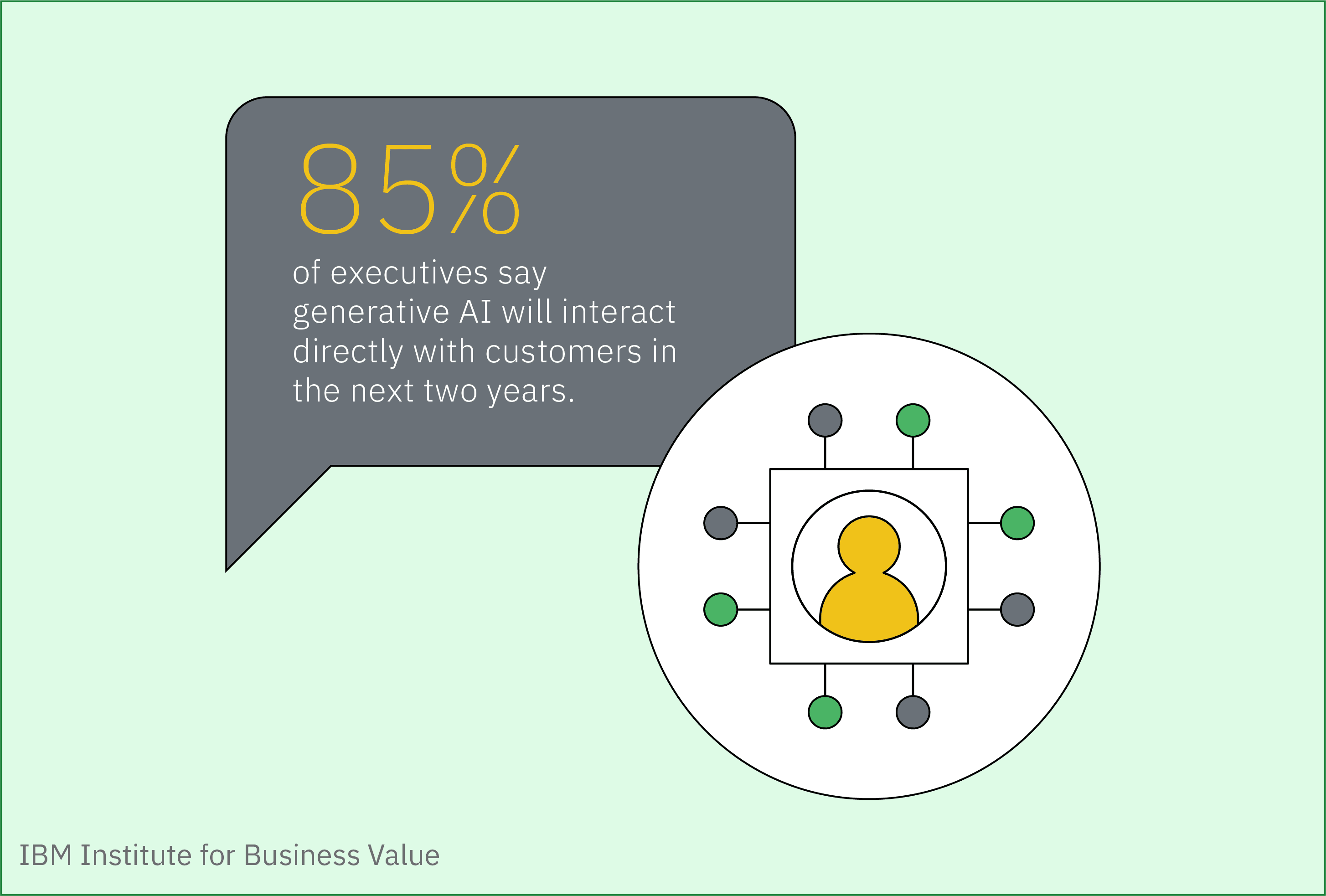
3. Align IT and business organizations behind an unshakable commitment to outcomes over outputs.
For Value Champions, experimentation, creativity, and “failing toward victory” advance a singular mission: a commitment to driving experiences, outcomes, and value for their customers—and their business.
This commitment creates unity, a purpose-driven enterprise that sees nearly 67% greater organizational alignment and 79% more employee satisfaction than Project Planners.
Value-driven commitment can make IT and the business organization fast friends and devoted allies. In fact, Champions are 130% more likely to enjoy tighter collaboration among product management, IT, and business stakeholders than Project Planners.
A unified, purpose-driven enterprise
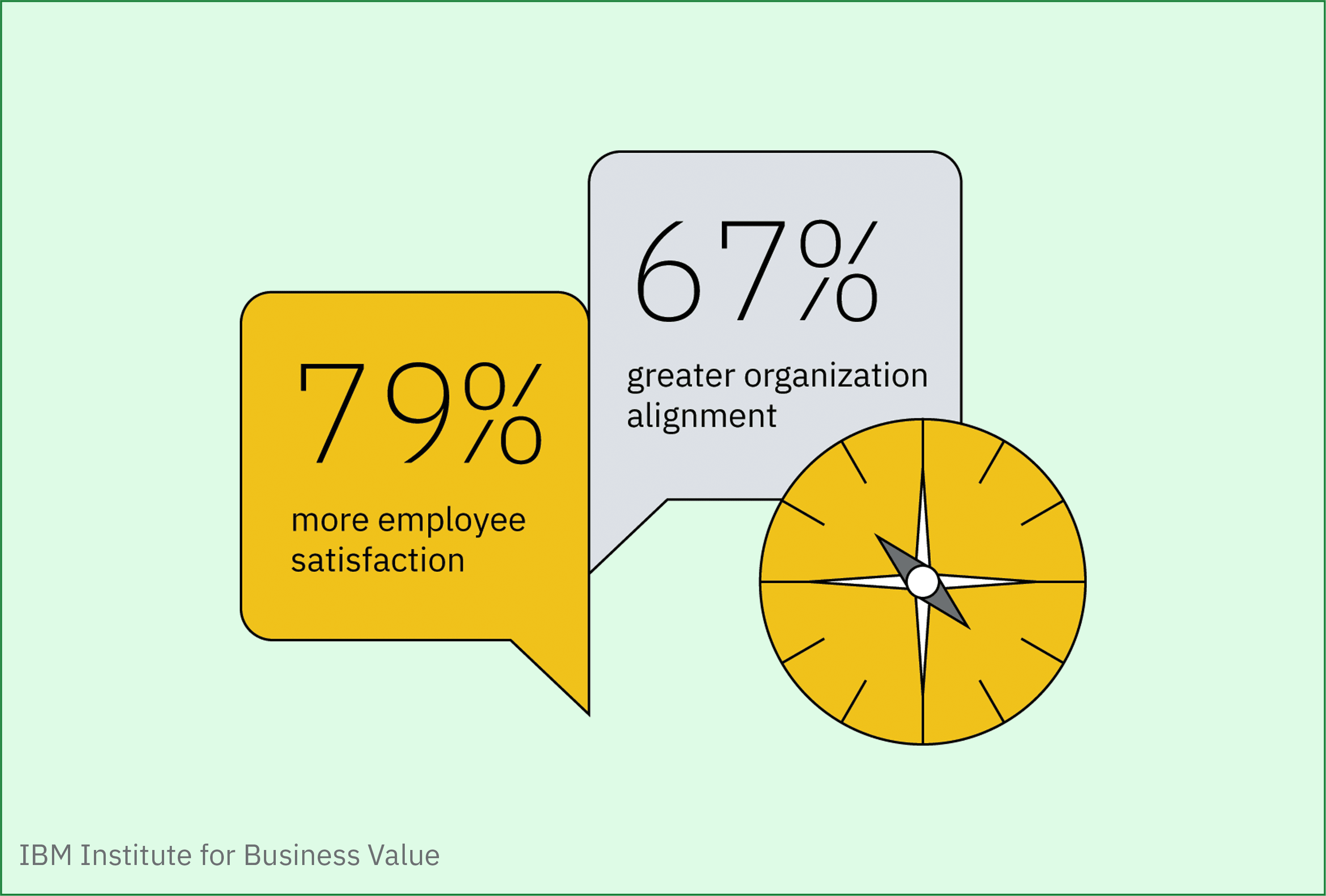
Both IT and business organizations thrive on creativity and innovation—but these characteristics evaporate in a barren, fearful desert devoid of free thinking. In fact, IBM IBV research shows that a culture of not penalizing failure in the context of technology adoption and digital transformation delivers a 10% revenue growth bump.
To that point, Value Champions are 53% more likely to support a culture of experimentation, failure, and learning than Project Planners. Champions don’t just advocate for their customers, they’re supporting their employees, too.
Value Champions build organizations that, by their nature, have a different DNA than those of Project Planners. Their cultures are both creative and logical: two-thirds (66%) of Value Champions are committed to exploring customer problems before devising solutions. Makes sense, right? Yet a mere 26% of Project Planners share this dedication—no surprise given their weakness at systemizing the intake of customer needs (see figure).
And another Champion advantage: more than half (55%) have established a top priority of improving existing products and services over the next two years. Value Champions see their products through the lens of the long haul, viewing them as ongoing processes. Champions don’t automatically jump on the next shiny trend—unless it drives value for the customer and the business.
Champions don’t just advocate for their customers, they’re supporting their employees, too.
Digging deeper
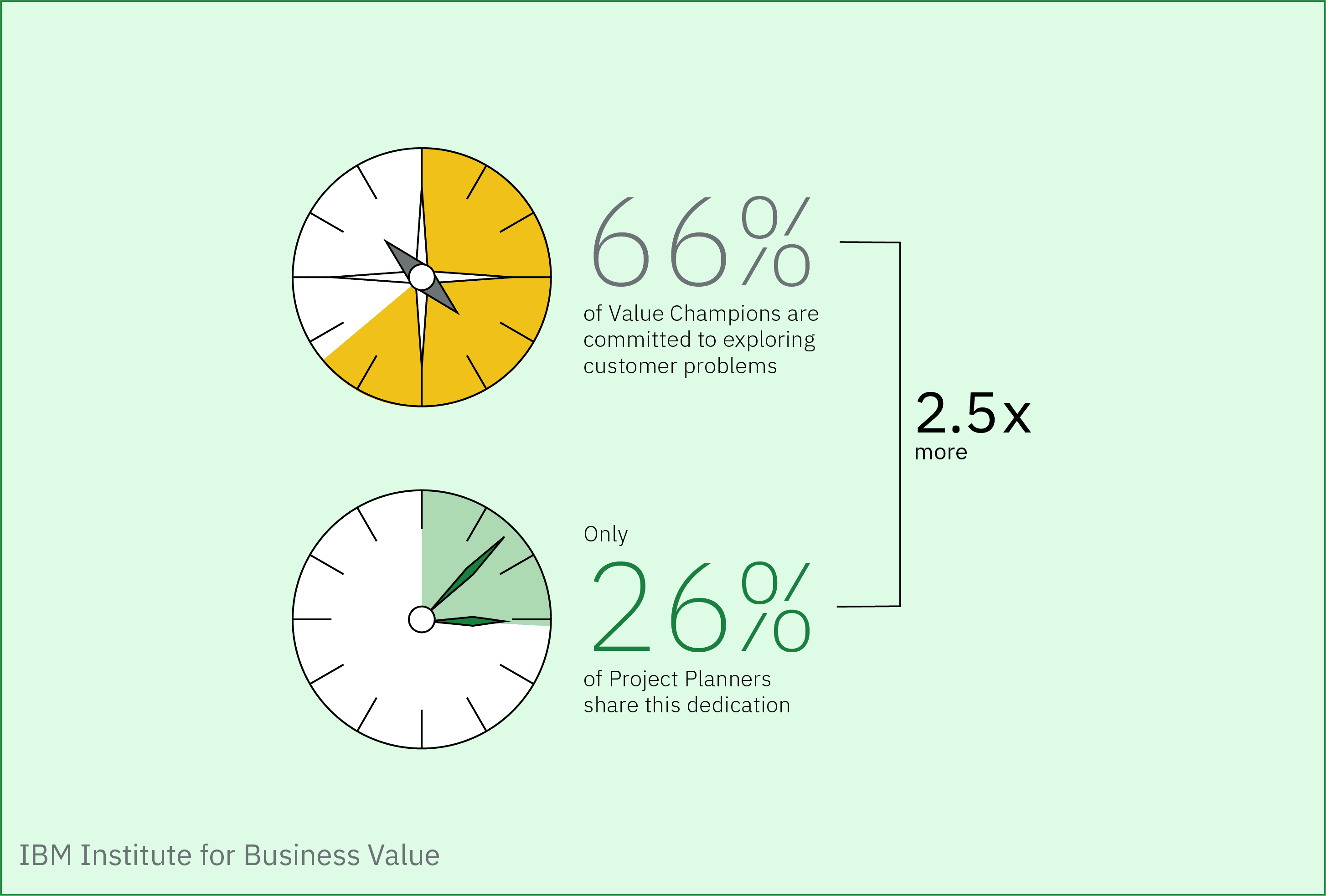
Case Study
Historically, this global auto manufacturer had a 100% centralized IT organization, which acted as a shared service across business domains to control costs in this historically low margin industry. However, the automotive industry has started to rapidly diversify, driven by new digital-first entrants. As a result, this original equipment manufacturer (OEM) needed to make fundamental changes to capture their share of new, higher-margin revenue streams.
The automaker decided to develop digital products that it could sell directly to consumers, such as navigation, emergency road services, autonomous driving, and entertainment packages. But it quickly encountered a roadblock: the existing centralized IT structure was slow, methodical, cost-contained, and overall unsuitable for agile software product development.
To address this issue, the automaker restructured its IT organization by spinning off a dedicated business unit focused on digital products. The new structure was aligned by product lines, with each having four functions: business, product, tech, and experience.
However, there were challenges in the transformation process. The automaker quickly realized that many of its foundational capabilities needed to build and deliver customer-facing products were insufficient, fragmented, or just out of date. To address these foundational issues, the automaker engaged IBM to help transform its core business-to-consumer capabilities.
The program had a host of objectives, including more stable customer experiences, more reliable customer interactions, faster release timelines, and more frictionless transactions, among others. At the end of the day, the organization will rely on these new capabilities to position it to grow its direct-to-consumer business by more than 20 times over the next five years.
More challenges lie ahead. But by restructuring and dedicating resources based on targeted digital business needs, the company has made significant strides toward achieving its goals in the rapidly evolving automotive industry.
Creating lasting success
The differences between Project Planners and Value Champions are nuanced, but they are no less critical. Our research shows key evidence that Project Planners can see fleeting success, while Value Champions can operationalize long-term success at the enterprise level.
The foundations of long-term success
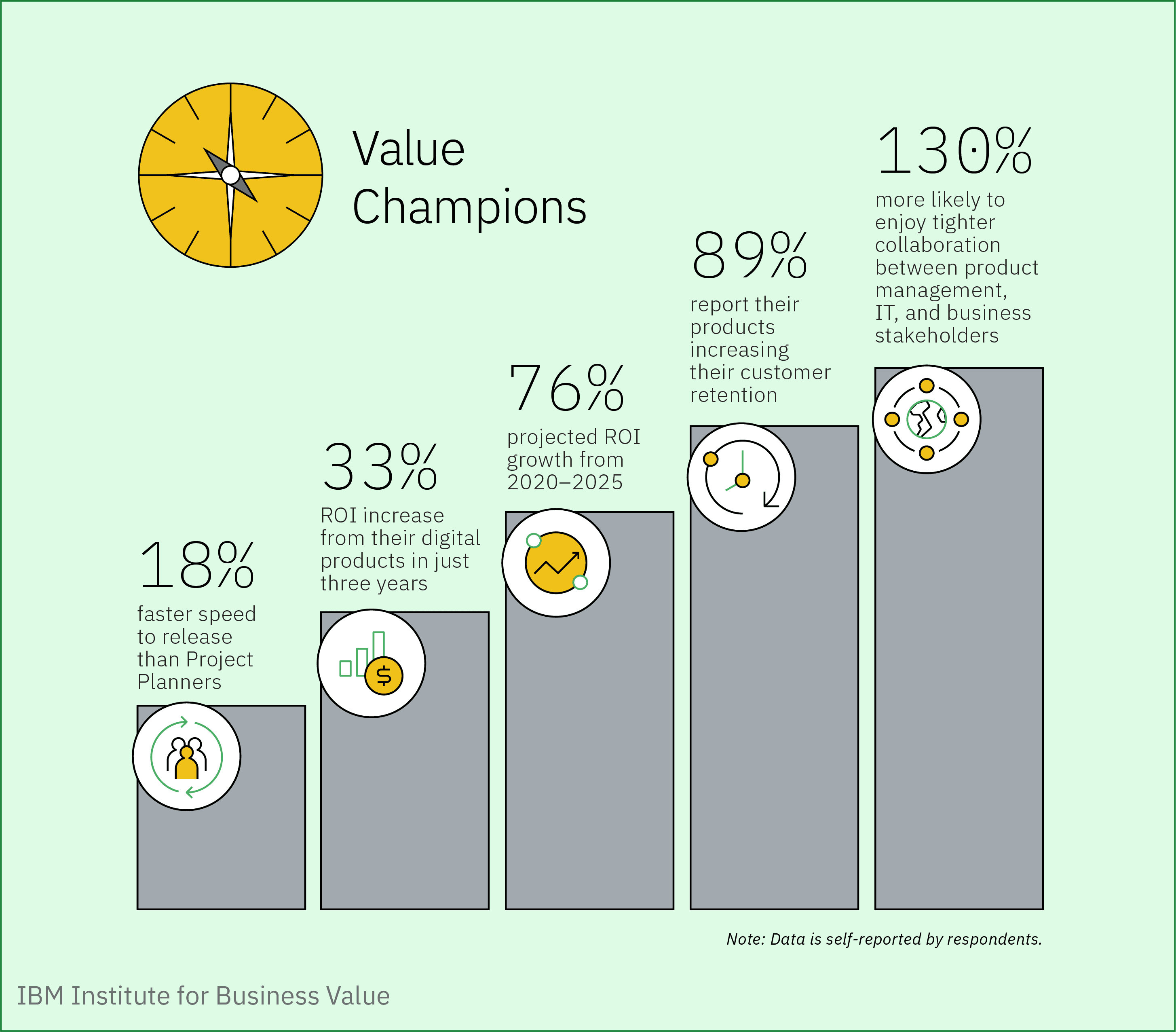
Planners can do well, for the moment, operating with an “output-focused” mindset. They might even understand the need for a broader, customer-centric perspective. But without the trifecta of customer, business, and product value driving their priorities, and a systematic way to operationalize outcomes over outputs, Project Planners risk losing momentum or even grinding to a halt the moment the market evolves yet again.
Value Champions evolve at scale, outperforming their Project Planner counterparts with more frequent releases that align with customer, business, and product needs. Champions know that delivering a product isn’t a one and done, it’s an ongoing relay that requires organizations to move with intention, sprinting in bursts to one finish line and strategically determining the next destination.
Value Champions are certain of this: if you think the finish line is the end, you’re finished.
Meet the authors
Scott Harper, Founder, CEO, DialexaDixie Adams, Managing Partner, Digital Product Engineering Consulting, IBM
Originally published 22 March 2024


